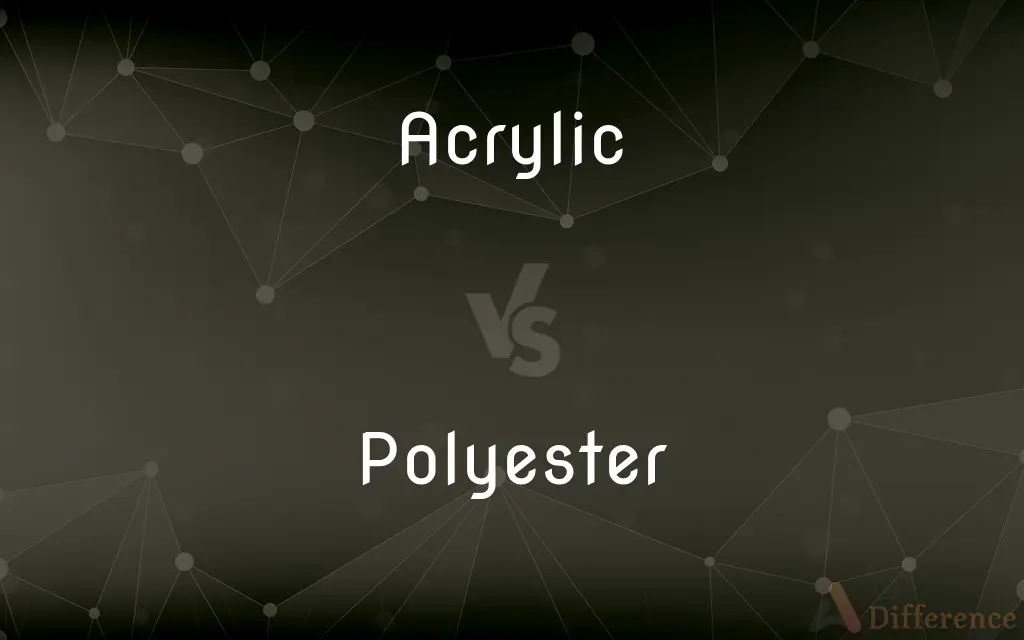Acrylic vs. Polyester — What's the Difference?
By Urooj Arif & Fiza Rafique — Updated on March 9, 2024
Acrylic is a synthetic fiber known for its wool-like feel, whereas polyester is a versatile and durable synthetic fabric used in various applications.

Difference Between Acrylic and Polyester
Table of Contents
ADVERTISEMENT
Key Differences
Acrylic, a synthetic polymer called polyacrylonitrile, is often used as a cheaper alternative to wool due to its softness and warmth. It's popular in sweaters, blankets, and outdoor clothing. Polyester, on the other hand, is a widely used synthetic fabric known for its strength, durability, and resistance to shrinking and stretching. It's utilized in everything from clothing to home furnishings and industrial applications.
While acrylic provides a level of warmth and comfort similar to natural wool, making it ideal for cold-weather garments and blankets, polyester excels in moisture-wicking and quick-drying properties, making it suitable for activewear and outdoor gear.
Acrylic fibers tend to be more lightweight and less sensitive to sunlight compared to polyester, which can be more prone to UV degradation. This makes acrylic a good choice for items like outdoor furniture covers that require lightness and resistance to weather elements. Polyester, whereas, offers better resistance to abrasions and is less likely to pill than acrylic, making it a preferred choice for items subject to high levels of wear and tear.
The environmental impact of both fibers is a point of concern, as both are petroleum-based and non-biodegradable. However, polyester has a slightly higher recycling rate due to its more widespread use and the development of technologies for polyester recycling. Acrylic production involves toxic substances, posing additional environmental and health risks.
Care and maintenance of acrylic and polyester differ; acrylic garments may require more delicate handling to avoid damage and pilling, whereas polyester is known for its ease of care, being machine washable and requiring minimal ironing.
ADVERTISEMENT
Comparison Chart
Composition
Synthetic polymer (polyacrylonitrile)
Synthetic polymer (polyethylene terephthalate)
Texture
Soft, wool-like
Smooth, can vary depending on processing
Durability
Less durable, prone to pilling
Highly durable, resistant to shrinking and stretching
Moisture Management
Less effective
Effective, quick-drying
Environmental Impact
Toxic production, non-biodegradable
Higher recycling rate, non-biodegradable
Compare with Definitions
Acrylic
Synthetic fiber mimicking wool's softness and warmth.
Her acrylic scarf felt surprisingly soft.
Polyester
Versatile synthetic fabric known for durability.
His polyester jacket has lasted for years.
Acrylic
Lighter and more resistant to sunlight than polyester.
Acrylic curtains are great for sunny rooms.
Polyester
Excels in moisture management and is ideal for activewear.
Her polyester shirt dried quickly during the hike.
Acrylic
Associated with environmental concerns due to toxic production.
The production of acrylic fibers releases harmful toxins.
Polyester
Used in a wide range of products from clothing to industrial materials.
Polyester fibers are used in tire reinforcements.
Acrylic
Used in products like sweaters and blankets.
The acrylic blanket kept them warm all winter.
Polyester
More environmentally friendly in terms of recyclability.
Recycled polyester is becoming more common in sustainable fashion.
Acrylic
Requires careful maintenance to avoid damage.
The acrylic fabric should be hand washed gently.
Polyester
Easy to care for, resistant to wrinkles and shrinking.
The polyester tablecloth is machine washable and durable.
Acrylic
(of synthetic resins and textile fibres) made from polymers of acrylic acid or acrylates
A red acrylic jumper
Polyester
Polyester is a category of polymers that contain the ester functional group in every repeat unit of their main chain. As a specific material, it most commonly refers to a type called polyethylene terephthalate (PET).
Acrylic
An acrylic textile fibre
A sweater in four-ply acrylic
Polyester
A synthetic resin in which the polymer units are linked by ester groups, used chiefly to make synthetic textile fibres.
Acrylic
An acrylic paint
Washes of white acrylic
She paints mainly in acrylics
Polyester
Any of numerous synthetic polymers produced chiefly by reaction of dicarboxylic acids with dihydric alcohols and used primarily as light, strong, weather-resistant resins in boat hulls, textile fibers, adhesives, and molded parts.
Acrylic
An acrylic resin.
Polyester
A wrinkle-resistant fabric of fibers made from any of these resins.
Acrylic
A paint containing acrylic resin.
Polyester
Any polymer whose monomers are linked together by ester bonds
Acrylic
A painting done in acrylic resin.
Polyester
A material or fabric made from polyester polymer
Acrylic
Any of numerous synthetic fibers polymerized from acrylonitrile.
Polyester
Of, or consisting of polyesters
Acrylic
(organic chemistry) Derived from acrylic acid or acrylonitrile.
Polyester
Any of numerous synthetic resins; they are light and strong and weather resistant
Acrylic
Containing an acrylic resin.
Polyester
A complex ester used for making fibers or resins or plastics or as a plasticizer
Acrylic
(organic chemistry) An acrylic resin.
Polyester
Any of a large class of synthetic fabrics
Acrylic
(painting) A paint containing an acrylic resin.
When it comes to painting, I prefer using acrylics as my medium.
Acrylic
A painting executed using such a paint.
Acrylic
A thick sheet of plastic.
Acrylic
A liquid coating system based on an acrylic resin.
Acrylic
Of or containing acryl, the hypothetical radical of which acrolein is the hydride; as, acrylic acid. The characteristic residue in an acrylic compound is the carbonyl group attached directly to an ethylenic carbon.
Acrylic
Same as acrylic resin.
Acrylic
Same as acrylic fiber.
Acrylic
A paint in which the pigment is suspended in a solution of an acrylic resin, which dries to a hard film on exposure to air.
Acrylic
A painting made using an acrylic paint.
Acrylic
Polymerized from acrylonitrile
Acrylic
A glassy thermoplastic; can be cast and molded or used in coatings and adhesives
Acrylic
Used especially by artists
Acrylic
A synthetic fabric
Common Curiosities
How does sunlight affect acrylic and polyester fabrics?
Acrylic is more resistant to sunlight, while polyester can be more prone to UV degradation.
Why is polyester so popular in clothing?
Polyester's durability, moisture-wicking, and easy-care properties make it popular in clothing.
What is acrylic best used for?
Acrylic is ideal for warm, lightweight clothing and blankets.
What are the care instructions for acrylic fabrics?
Acrylic items often require gentle washing and avoidance of high heat.
Can acrylic fabric be recycled?
Recycling is possible but less common due to its chemical composition and production process.
Is polyester clothing comfortable?
Comfort can vary; modern polyester blends are designed for comfort and breathability.
Can acrylic fabrics cause allergies?
Acrylic is generally hypoallergenic, but some may experience irritation due to its synthetic nature.
How does polyester perform in wet conditions?
Polyester dries quickly and is resistant to water, making it good for wet conditions.
Are acrylic and polyester eco-friendly?
Both have environmental impacts, but polyester has a higher recycling rate.
Do acrylic fabrics pill easily?
Yes, acrylic can pill more easily than polyester, especially under friction.
Can acrylic keep you warm in winter?
Yes, acrylic has good warmth retention, making it suitable for winter wear.
Is polyester suitable for outdoor furniture?
Yes, due to its durability and resistance to wear, polyester is suitable for outdoor furniture.
How does the cost of acrylic compare to polyester?
Acrylic can be cheaper or similarly priced to polyester, depending on the quality and brand.
Is polyester breathable?
Traditional polyester is less breathable, but many modern blends are designed to improve breathability.
Are there hypoallergenic options for both acrylic and polyester?
Yes, both fibers can be processed in ways to reduce allergenic properties.
Share Your Discovery

Previous Comparison
Pupil vs. Iris
Next Comparison
Ellipsoid vs. SpheroidAuthor Spotlight
Written by
Urooj ArifUrooj is a skilled content writer at Ask Difference, known for her exceptional ability to simplify complex topics into engaging and informative content. With a passion for research and a flair for clear, concise writing, she consistently delivers articles that resonate with our diverse audience.
Co-written by
Fiza RafiqueFiza Rafique is a skilled content writer at AskDifference.com, where she meticulously refines and enhances written pieces. Drawing from her vast editorial expertise, Fiza ensures clarity, accuracy, and precision in every article. Passionate about language, she continually seeks to elevate the quality of content for readers worldwide.
















































